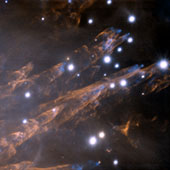Orion Bullets
This near-infrared image shows supersonic 'bullets' of gas and the wakes created as they pierce through clouds of molecular hydrogen in the Orion Nebula. The image was made possible with new laser guide star adaptive optics technology that corrects in real time for image distortions caused by Earth's atmosphere. The Orion Nebula is a star-forming region located relatively near to us, about 1,500 light-years away. It's a young stellar nursery and shows many unusual features related to the effect of massive stars on the dense birth environment of gas and dust. The Orion bullets were first seen in a visible-light image in 1983. By 1992, images taken at infrared wavelengths led astronomers to conclude that these clumps of gas were ejected from deep within the nebula following an unknown violent event connected with the recent formation of a cluster of massive stars there. The bullets are speeding outward from the cloud at up to 400 kilometers (250 miles) per second. This is more than a thousand times faster than the speed of sound. The name 'bullet' is somewhat misleading since these objects are truly gigantic. The typical size of one of the bullet tips is about ten times the size of Pluto's orbit around the Sun. The wakes shown in the image are about a fifth of a light-year long.
| Observatory: | Gemini Observatory (North) Mauna Kea, Hawai'i |
|---|---|
| Telescope: | Gemini North |
| Instrument: | NIRI+Altair |
| Astronomer: | S. Fisher (Gemini Observatory) and T. A. Rector (University of Alaska Anchorage) |
| Date of Observation: | 03-06-2007 |
| Filters and Assigned Colors: | FeII (blue), H2 (orange) and K-2.2 microns (white) |
| Exposure Times: | 27x30sec for FeII, 13x10sec for H2 and 9x15sec for K |
| Location of Image: | Orion |
| Field of View: | 50 x 50 arcsec |
| Orientation: | Rotated 45 degrees CW from north is up, East is to the left |
| Link to Larger Image | |
| Link to Full Resolution Image | |
| © Copyright Statement |
